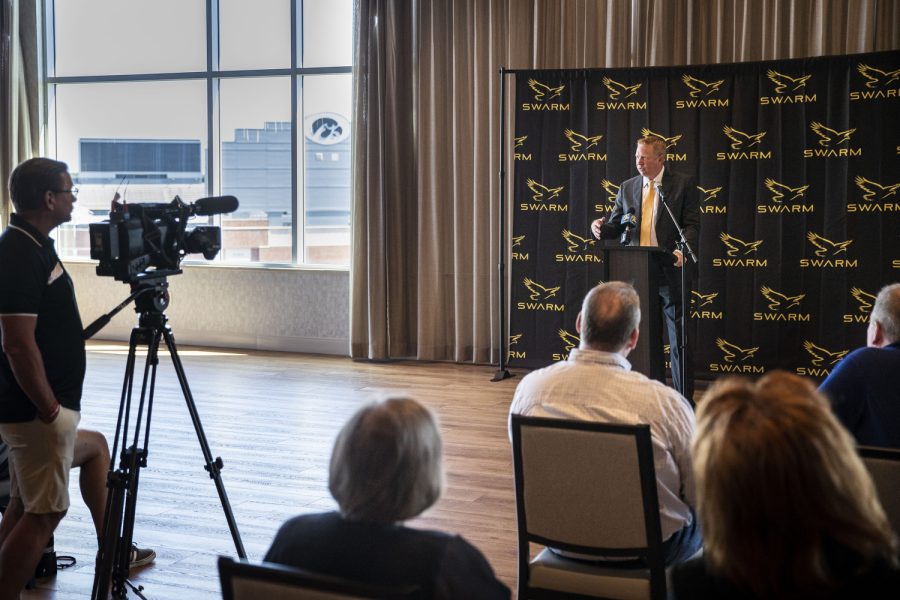The NCAA passed name, image, and likeness, or NIL, legislation in June 2021, allowing student-athletes to make money from their physical representation.
Since its implementation, NIL has been a popular research topic and has sparked public debate. A primary concern surrounding NIL is how student-athletes will balance their sport, education, and new brand deals.
Now, more than ever, NIL deals at strong sports programs attract student-athletes for their athletic success and successive compensation — not for their academic offerings.
Iowa’s own Kirk Ferentz has expressed concern about the transfer portal and NIL, saying the game has turned into a pay-for-play environment. Pay-for-play refers to any situation in which a service is exchanged for money. Ferentz believes there’s no structure and doesn’t see the legislation as being sustainable.
His concerns make sense. Some companies pay student-athletes $1,000 just for posting a TikTok featuring their product. Why would they prioritize schoolwork over something that can make them money so quickly?
These issues with collegiate athletes predate NIL. Cardale Jones, a former Ohio State quarterback, famously tweeted, “Why should we have to go to class if we come here to play FOOTBALL, we ain’t come to play SCHOOL, classes are POINTLESS.”
Universities are known to emphasize athletics over academics. The reason for this is obvious: Colleges make more money when their teams perform well.
The introduction of NIL complicates an already complex process. Standout athletes likely to be drafted into professional leagues benefit the most from NIL, followed by those in high-profile programs like football or basketball. These athletes often enter college with an existing social media presence that grows as games are broadcasted across the country. NIL companies are quick to profit off the success and appeal of such athletes.
For all student-athletes, brand deals add an extra burden to an already demanding schedule, especially for those with fewer resources.
Time management is a significant issue for student-athletes, who spend more than 25 hours a week on sports-related activities, not including games. With so much time already devoted to their sport, NIL partnerships further reduce the time available for schoolwork because athletes are now expected to create content for paid partnerships and review contracts.
With the added pressure of NIL, along with the stress of practices and games, student-athletes may feel more incentive to cheat on tests, plagiarize assignments, or pay others to complete their work.
If a student-athlete receives an NIL deal, the company might push them to maintain their GPA to retain eligibility. If the student’s grades slip, what’s stopping the business from pressuring the university to adjust their grades?
This pressure from businesses to the university can take the form of letters to the college’s president, a suggestion to the course instructor, or sending a reminder about the importance of the particular athlete to the dean of students.
While it may seem harmless for companies to ask deans or professors about a student’s academic performance, it could influence how the professor grades that student to preserve the business relationship.
Brand partnerships can also negatively impact student-athletes’ mental health. Whether it’s stress over contracts, missed opportunities, or watching teammates earn more, NIL deals can strain their well-being.
Poor mental health is linked to increased absences in class and incomplete assignments. Stress and anxiety can lower energy levels and make it difficult to concentrate.
Iowa Swarm, founded in 2022 as a nonprofit organization, supports Iowa athletes with their NIL deals and community partnerships. A collective like this, while associated with the university but not affiliated, can incentivize high school athletes to apply. Programs like this fixate students focus solely on athletic pursuits while putting the academic facet of a particular college on the back burner.
The NIL program should place greater emphasis on its academic mission. While student-athletes must maintain a certain GPA to qualify for NIL deals, academics are not promoted as a central focus of the initiative.
Universities should consider offering courses focused on NIL, teaching students how to read contracts, navigate business interactions, and market themselves. This could help student-athletes manage their academics alongside brand obligations.
In January, a new proposal was added to NIL legislation allowing colleges to support student-athletes with brand deals and partnerships. Indiana University Bloomington has already created a course through its media school covering branding, marketing, and all things NIL. TCU has followed suit, and professors expect more universities to introduce similar courses.
Although many current student-athletes have aspirations of playing at the professional level after college, the chance that an athlete makes their sport’s professional league — and stays there — is a long shot. The average career of a pro sports player in any league is less than five years, and the chance a college athlete makes it to the league in the first place is less than two percent. Having a college degree can give retired pros options following their departure from the professional ranks.
For student-athletes who don’t plan on going pro, focusing on school and receiving a degree is the best way to go about getting a high paying job after graduation. Future employers won’t be impressed that they skipped class to focus on a sport they don’t play anymore.
Ultimately, it’s up to universities to motivate athletes to focus on their academics. If college coaches aren’t encouraging their student-athletes to excel in school, who will?



